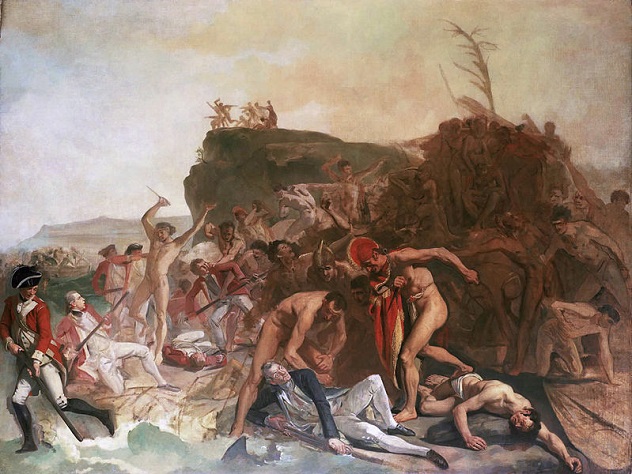 Mysteries
Mysteries  Mysteries
Mysteries  History
History 10 Surprising Stories About the Texas Rangers
 Humans
Humans 10 Philosophers Who Were Driven Mad by Their Own Theories
 Miscellaneous
Miscellaneous 10 Video-Game-Worthy Weapons and Armors from History
 Weird Stuff
Weird Stuff 10 Psychics Who Accurately Predicted Wartime Events
 The Arts
The Arts 10 Pieces of Art Inspired by a Broken Heart
 Health
Health 10 Science Fiction-Sounding New Medical Treatments
 History
History 10 Surprising Facts About the Father of Submarine Warfare
 Space
Space Ten Astonishing New Insights into Alien Worlds
 Weird Stuff
Weird Stuff 10 Bizarre Summer Solstice Rituals Still Practiced Today
 Mysteries
Mysteries Top 10 Haunting Facts About the Ghost Ship MV Alta
 History
History 10 Surprising Stories About the Texas Rangers
 Humans
Humans 10 Philosophers Who Were Driven Mad by Their Own Theories
Who's Behind Listverse?

Jamie Frater
Head Editor
Jamie founded Listverse due to an insatiable desire to share fascinating, obscure, and bizarre facts. He has been a guest speaker on numerous national radio and television stations and is a five time published author.
More About Us Miscellaneous
Miscellaneous 10 Video-Game-Worthy Weapons and Armors from History
 Weird Stuff
Weird Stuff 10 Psychics Who Accurately Predicted Wartime Events
 The Arts
The Arts 10 Pieces of Art Inspired by a Broken Heart
 Health
Health 10 Science Fiction-Sounding New Medical Treatments
 History
History 10 Surprising Facts About the Father of Submarine Warfare
 Space
Space Ten Astonishing New Insights into Alien Worlds
 Weird Stuff
Weird Stuff 10 Bizarre Summer Solstice Rituals Still Practiced Today
10 R-Rated History Facts You Won’t Learn In School
Let’s face it—schools could do a much better job of making history fascinating for students. Teachers seem obsessed with getting us to remember dates of wars and reigns and often forego the juicy bits that make history so much more captivating. Admittedly, it’s hard to include all the sex, violence, and debauchery in a school curriculum, but a bit of salaciousness does wonders to kindle one’s interest.
10 James Cook Was Mistaken For A Sex God

British navigator James Cook became famous for his voyages where he explored regions barely known to Europeans, such as Australia and New Zealand. During his third voyage between 1776 and 1779, Cook explored the islands in the Pacific. It was here that Cook met his demise at the hands of Hawaiian natives, and it might have had something to do with him being mistaken for Lono, god of fertility.
Cook’s first contact with the natives in 1778 was friendly. They traded with each other and exchanged gifts. After establishing a successful relationship, Cook continued exploring the archipelago. He returned to Hawaii in 1779 to winter in Kealakekua Bay. However, he happened to arrive during Makahiki, a festival in honor of Lono, and many Hawaiian priests took it as a sign that Cook was actually the god returned from his travels.
At first, this was a stroke of fortune. Cook was paraded from village to village where he was met with gifts, supplies, and sacrifices. However, the Hawaiians soon became concerned with the Europeans’ disregard for their culture. The relationship worsened when Cook and his men began using wooden idols of Lono as firewood.
Due to a cultural misunderstanding, natives tried to take goods from the Europeans on several occasions. Eventually, Cook’s men began retaliating with gunfire, which led to several extended conflicts. As a final gamble to end hostilities, Cook kidnapped the king of the island, King Kalani’opu’u, but was beaten to death on his way back to the ship (shown in the painting above).
9 The October Revolution Led To A Massive Drinking Binge

The October Revolution of 1917 officially ended the Tsarist regime and shifted power to the Bolsheviks. The defining moment of this insurrection was the assault on the Winter Palace in Saint Petersburg, the official residence of the monarch. It was almost a bloodless affair. The palace was mostly guarded by cadets and female soldiers who surrendered to a superior force with superior firepower. A few years later, Lenin staged “The Storming of the Winter Palace,” a reenactment witnessed by 100,000 people which portrayed the Bolsheviks in a much more heroic light and became the official story. It also omitted the fact that after seizing the palace, the Bolsheviks got completely stinking drunk.
While exploring the palace, the revolutionaries stumbled upon the Tsar’s secret stash—the largest wine cellar in the world. This discovery sunk most of the city into a drunken stupor for days on end.
Any efforts from the few sober Bolsheviks to try and contain the situation were completely in vain. They barricaded the cellar, but the thirsty mob knocked down the wall. They poured the wine down the drain, but crowds of people simply gathered at the other end, drinking straight out of the drainpipes. People even died in the freezing waters of the Neva trying to recover crates that were thrown into the river. It wasn’t until the new year that the city finally restored some semblance of order.
8 The Ballet Of Chestnuts

The House of Borgia is well-known for the power it attained in Renaissance Italy and all the crimes, depravity, and debauchery that came along with it. Arguably the most influential member of the family was Rodrigo Borgia, who became Pope Alexander VI. His papacy was fraught with controversy due mainly to his many illegitimate children by several mistresses.
One of those children was Cesare Borgia who, with the help of his father, became a cardinal. On October 30, 1501, Cesare allegedly staged what was probably the most depraved party ever held at the Papal Palace—the Ballet of the Chestnuts.
Along with nobles, clergymen, and everyone else you might expect at this kind of event, 50 prostitutes were invited to attend the banquet. At first, they simply danced to entertain the guests. After a while, servants covered the floor with chestnuts. The prostitutes undressed, got down on all fours and proceeded to crawl between attendees, collecting all the chestnuts. Afterward, the guests were invited to have sex with the prostitutes, and rewards were even offered for the ones who showed the most stamina. All the while, the pope and his entourage sat back and enjoyed the show.
Although this kind of debauchery fits perfectly with the historical view we have of the Borgias, not everyone agrees on the chain of events. The only written source for the banquet comes from Johann Burchard, who mentioned it in Liber Notarum, his compendium on all the papal ceremonies he attended. While Burchard was a respected chronicler, he also wasn’t a friend of the Borgias.
7 Olga Of Kiev’s Revenge

Today, Saint Olga is an important figure in the Russian Eastern Orthodox Church. During the 10th century, she was the wife of Igor I, ruler of the Kievan Rus’, a federation of Slavic tribes extending over regions of Russia, Ukraine, and Belarus. Prince Igor was killed by the Drevlians when he went to collect tribute. The Drevlians then sent word to Olga, demanding that she marry their Prince Mal.
According to the Primary Chronicle (our main source of information on the Kievan Rus’), Olga embarked on a bloody journey of vengeance. She started out by burying alive the Drevlian envoy who came with the demand. Then, Olga sent word to the Drevlians that she accepted their proposal and that they should send their most distinguished men after her so that she might leave Kiev with honor. The Drevlians obliged and, when their new retinue arrived, Olga invited them to bathe in the bathhouse. She then had her men lock it up and burn them alive (shown above).
Unaware of the gruesome fates of their brethren, the Drevlians prepared a feast when Olga arrived. When they were all drunk, Olga had her men slaughter everyone in attendance. The survivors offered to pay her tribute, but Olga only asked for three sparrows and three pigeons from each house. The Drevlians happily complied, but Olga took the birds and tied embers to their feet and released them. The birds returned to their homes, quickly setting the whole city on fire.
6One Of Europe’s Most Powerful Dynasties Was Destroyed By Inbreeding

The House of Hapsburg was one of the most influential families in history. They ruled the Holy Roman Empire for 300 years. At times, they also ruled over most other European monarchies. Spain was under Hapsburg rule for almost 200 years, but their bloodline was brought to a screeching halt due to their severe inbreeding.
Charles II was the last Hapsburg ruler of Spain. He was noted for his many physical and mental disabilities and—although he was married twice and had a lengthy, 30-year reign—Charles was incapable of producing any heirs. Back then, his ailments were ascribed to witchcraft, and he was known as Charles the Hexed. Now we know it was because of severe inbreeding.
Some inbreeding was not uncommon for that time, as all royal families cherished their bloodlines. However, the Spanish Hapsburgs went way overboard and became known for constantly marrying their royalty to uncles, nieces, and first cousins. A team of scientists used genealogical information from 3,000 Hapsburg family members spanning 16 generations and established an inbreeding coefficient (F). It denoted the probability of inheriting similar genes from both parents. Philip I, founder of the dynasty, had an (F) of 0.025. Charles II had an (F) of 0.254, 10 times larger.
Charles was far from the only Hapsburg with an abnormally high inbreeding coefficient. Due to this deficiency, only half of the family’s children lived more than a year. This was at a time when even children in Spanish villages had an 80 percent chance of seeing their first birthday.
5 Ancient Rome Was Covered In Vulgar Graffiti

Historians have a certain fascination with graffiti. It provides us with a unique look into the ancient world by acting as the voice of the common man instead of the elite or the scholar. Thanks to well-preserved cities like Pompeii and Herculaneum, we have a lot of surviving examples of the type of graffiti that adorned the walls of the Roman Empire. For example, it would appear that Nero was more popular with the people than history books would have us believe. There are also many inspirational examples like declarations of love, clever wordplay, political opinions, and statements of goodwill.
Then there is also the filth. Like so many public bathroom stalls of today, Rome’s walls were covered in vulgar graffiti. Many examples were simple insults, straight to the point: calling Oppius a clown, Teritus a “nasty boy,” and Phileros a eunuch.
A lot of graffiti consisted of men showing off their sexual prowess. Outside the Bar of Athictus in Pompeii, we find a rather direct example (“I screwed the barmaid”) and a relatively poetic one (“Floronius, privileged soldier of the 7th legion, was here. The women did not know of his presence. Only six women came to know, too few for such a stallion”). And many pieces of graffiti seem to be scatological, although not necessarily negative. One example outside the Vesuvius gate wishes the reader a fortuitous bowel movement: “Defecator, may everything turn out okay so that you can leave this place.”
4 The Real James Bond

The basis for James Bond’s character remains a matter of debate. As a former naval intelligence officer, Ian Fleming met his fair share of interesting men, but the one who acted the most like Agent 007’s character was Dusan Popov.
Popov was a double agent. During World War II, he worked for the German Abwehr as well as the British MI6. Despite his animosity toward Nazis, Popov became a valuable asset to the Germans, who never realized that every piece of information he gave them was pre-approved by the Secret Intelligence Service.
His work aside, Popov was a prodigious womanizer, drinker, and gambler. In fact, his code name with MI6 was changed from Scoot to Tricycle due to his fondness for menages a trois. This party attitude caused him trouble when Popov traveled to America. Within a few weeks, Popov was partying in a Park Avenue penthouse with the rich and famous to the annoyance of FBI Director J. Edgar Hoover. He didn’t trust Popov at all and ignored all information he provided. Hoover even threatened to arrest Popov for violating the Mann Act if he didn’t leave the country.
Popov’s most Bondesque moment happened at a Portuguese casino, and Ian Fleming was there to witness it. He was playing baccarat at a table with a wealthy Lithuanian. Whenever the Lithuanian was holding the bank, instead of setting a limit as is customary, he pompously proclaimed “banque ouverte,” meaning he would match any bets made by other players.
Annoyed, Popov placed a bet of $50,000 using Her Majesty’s money. Fleming, who was observing from a distance, turned pale. It was enough to make the Lithuanian back down from his arrogant claim, though, and the event inspired the iconic poker scene in Casino Royale.
3 One Of The World’s Largest Cutlery Companies Started As A Free Love Commune

Today, Oneida Limited is the largest supplier of dinnerware to the food service industry in North America and one of the largest flatware manufacturers in the world. The company was founded in 1880, but it traces its origins a few decades earlier to a religious commune in upstate New York.
In 1848, American preacher John Humphrey Noyes and his dozens of followers settled down to try and recreate their vision of a socialist utopia. They named it the Oneida Community and became followers of a new religious movement called Perfectionism.
Perfectionism had several beliefs that went against the accepted views of the day. The movement urged its followers to attain perfection by becoming free of sin in this life. Communalism was also an important tenet regularly practiced by the Oneida Community. However, it was another core concept of perfectionism that gained its notoriety—complex marriages.
Noyes didn’t like the standard monogamous relationships of the day (which he called “simple marriages”), so he instituted his own concept within the Oneida Community. Under a complex marriage, every woman became the wife of every man and every man the husband of every woman. Sexual relations were allowed between different partners as long as there was mutual agreement and men took steps to avoid pregnancy.
The community flourished over the next decades and established itself in other cities. However, Noyes had to flee to Canada to avoid adultery charges. In 1879, the Oneida Community renounced complex marriages and, a year later, officially dissolved and converted into a joint-stock company.
2 The Beggar’s Benison

During the 18th century, clubs were the main places where like-minded gentlemen gathered to discuss matters of interest to them. Some clubs focused on politics and commerce, others on science. And certain clubs were all about one thing—sex.
That was the case with the Beggar’s Benison, often touted as Scotland’s first sex club. Its full name was The Most Ancient and Most Puissant Order of the Beggar’s Benison and Merryland, Anstruther. The name referenced a story in which King James V received a blessing from a beautiful, young beggar girl, exemplified by the club’s motto: “May Prick and Purse Never Fail You.”
The goal of the Beggar’s Benison was to celebrate male sexuality. This usually meant talking about sex, looking at pornography, and sometimes being entertained by nude “posture girls.” Club members also likely indulged in group masturbation in protest of the accepted view of the day that onanism (masturbation) was a “health and social problem.” The Beggar’s Benison lasted for almost 100 years before closing in 1836. Today, we are mostly left with a few documents and records of their meetings, as well as several novelty phallic relics preserved in museums.
1The Congress Of Vienna Was One Long Party

The Congress of Vienna was a pivotal moment in Europe’s history. Following Napoleon’s defeat, other powers came together to reach a long-term peace plan that would provide some much-needed stability to a Europe ravished by decades of wars. It lasted for nine months between September 1814 and June 1815 and it was mostly about Europe’s remaining powers—Britain, Austria, Russia, and Prussia—agreeing on new borders that wouldn’t give too much power to any one nation.
The Congress gathered Europe’s most powerful people in the same city for almost a year. And when they weren’t busy with politics, they were steeped in a world of sex, parties, and alcohol.
British ambassador Robert Stewart, Lord Castlereagh, became well-known to Viennese police for his many drunken exploits. One memorable example was an altercation between the British official and a carriage driver after a traffic dispute. Drunk after a few bottles of Bordeaux, the ambassador cursed the driver and challenged him to a fistfight while bragging about his boxing experience. The coachman, who spoke no English, simply cracked Stewart in the face with his whip and would have thrown him into the Danube if police didn’t arrive.
Austria’s main representative, Prince Klemens von Metternich, preferred women to wine and had numerous affairs during the Congress. Both Tsar Alexander (above) and British diplomat Frederick Lamb slept with mistresses of Metternich under the pretext of seducing them for information. Even the defeated French ambassador Prince de Talleyrand joined the festivities by sleeping with a mother and her daughter.
Radu loves weird and naughty facts about history. Share the knowledge on Twitter or check out his website.








